Jacob S Paulsen's Blog, page 12
February 24, 2015
Guide to Outsourcing Stuff Worth Less than My Time
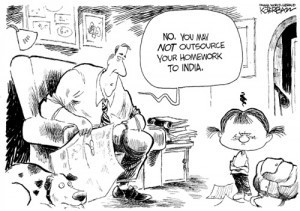 My first introduction to outsourcing was from Timothy Ferris’s book, The Four Hour Work Week. Since then I’ve gradually increased the amount of things I outsource. While I’m still not to the point where I would like to be, I’m very comfortable with the process and have been successful in identifying some of the tasks in my world that should be outsourced. In my own view I still have a long way to go but recently a friend commented on how much he appreciated my success in outsourcing and wished he could get started. I write this article for anyone who wants to explore this but isn’t sure where to start.
My first introduction to outsourcing was from Timothy Ferris’s book, The Four Hour Work Week. Since then I’ve gradually increased the amount of things I outsource. While I’m still not to the point where I would like to be, I’m very comfortable with the process and have been successful in identifying some of the tasks in my world that should be outsourced. In my own view I still have a long way to go but recently a friend commented on how much he appreciated my success in outsourcing and wished he could get started. I write this article for anyone who wants to explore this but isn’t sure where to start.
To Outsource or Not to Outsource
In order to determine if you should outsource something you need to answer three key questions:
1. Would it take more time for me to explain what/how to do it than it would for me to do it?
2. Based on how much my time is worth, would I lose money by doing this task myself?
3. If I regain the time I would have spent on this task by outsourcing it, can I fill that time with something equally or more valuable?
Question two of course implies that you know what your time is worth. If you haven’t already you need to have a clear sense for what one hour of your time is worth. Calculate this by taking your annual take home revenue and dividing it by the total number of working hours.
What to Outsource?
About any task you can think of can be outsourced. Anything from online research, business PowerPoint presentations, online shopping, data entry, programming, graphic design, responding to emails, and much much more. The key for you, based on the above questions, is to identify the tasks that take your energy and limit your total output per hour.
For me I focus on outsourcing several key activities.
All Data Entry. All Programming/Coding. All Research.
Where to Outsource?
There are several good resources you can draw on in starting your new outsourcing lifestyle. First, there are many organization that specialize in certain types of tasks. If you need mostly personal assistant stuff (buy things, send flowers, research travel) you can go to someone like YourManInIndia.com and their group will take care of you. If you need mostly business and professional tasks (sales decks, reports, market research, business plans) you can work with someone like BrickWorkIndia.com. These types of specialized groups are going to have more consistent quality, deeper resources, and faster execution. They will demand a premium price.
If you want to start small, or aren’t sure where to go you can try one of several different freelancer websites like, elance.com, freelancer.com, odesk.com, and post your project for all the various freelancers in the world to bid on it. This is my method of choice. It gives me options, guarantees competitive pricing, and allows me to meet talented people I can rehire in the future for similar work. This is how I have found my best designers, programmers, and writers.
How to Outsource?
Quality experiences and quality task completion at or under budget happens only when you know how to work with your freelancer. The key is in project description. Here are some tips:
1. Always error on the side of being overly detailed and clear in the project/task description.
2. Always ask the freelancer to check in with you a few hours into the project so you can confirm they are doing what you asked how you want it.
3. Whenever possible give the freelancer an example of something similar to the desired outcome.
4. Read reviews and ask for references.
5. Ask the freelancer to provide a quick sample or to repeat back to you in their words what they understood as the task.
Original article: Guide to Outsourcing Stuff Worth Less than My Time.





January 28, 2015
Setting Up a Landing Pages and Sales Letters With WooCommerce
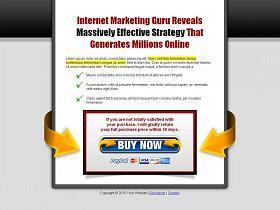 An effective way to increase eCommerce sales and conversion is to build a simple sales page that eliminates the traditional menus, headers, and sidebars that most websites have. These sales pages or sales letters are proven to increase conversion as the customer is made to focus on the value proposition and make a decision. I use WordPress for most of my sites, and I prefer WooCommerce for my shopping cart software. Trying to find a way to integrate WooCommerce into a Sales Page has proven to be challenging to say the least.
An effective way to increase eCommerce sales and conversion is to build a simple sales page that eliminates the traditional menus, headers, and sidebars that most websites have. These sales pages or sales letters are proven to increase conversion as the customer is made to focus on the value proposition and make a decision. I use WordPress for most of my sites, and I prefer WooCommerce for my shopping cart software. Trying to find a way to integrate WooCommerce into a Sales Page has proven to be challenging to say the least.
What Didn’t Work – Don’t Waste Your Time
I found various number of websites that stated that the best solution was to use custom CSS codes to block out and eliminate everything from the navigation menu and above from view on a specific page. This is not only tedious but also requires a little know how if you can get it to work at all. Don’t bother
I found a small number of plugins that boast being able to create awesome and amazing landing pages. After going through all the free ones I even shelled out some cash for a few paid products but they still just didn’t do the job. They play with taxonomies and permalinks and conflicted with other plugins and sometimes didn’t even work. Further, they don’t play well with WooCommerce or other parts of your existing WooTheme because they ignore the CSS and go in their own direction.
The Simple Solution
The correct way to do this, and what I obviously ended up doing for myself, what to build (or buy) page templates that can live within your current theme (woo or otherwise) and create the landing page look that you need without disrupting the rest of this site. By doing this you need only to add a standard page within WordPress and select the new template. Input your content and publish. I was able to dig up a few free page template solutions that were so-so, but eventually purchased a $27 package that included about a dozen pre-built sales letters / landing pages that can be used as stand alone themes or can be added as page templates to an existing theme. Poof, magic is happening. Here is the one I bought: WP Landing Page Templates.
The Integration with WooCommerce
There are a couple of options depending on what you are inclined to do. The simplest solution is to put an Add to cart icon or button on your sales page and link it directly to the cart/check, adding your product to the cart in the process. The shortcode looks something like:
http://www.yourdomain.com/cart/?add-t... — where 67 is the product ID. This URL will take the customer directly to your cart and add product 67 to the cart.
As an alternative you can replace “cart” with “checkout” and take the customer directly to checkout.
You can also create direct URLs for specific variations on products that have variations. An Example would be:
http://www.yourdomain.com/cart/?add-t...
Where:
67 is the product ID
3721 is the Variation ID
“left-or-right” is the variation slug
“right-handed” is the slug for the specific variation option to be added to the cart
If you prefer to use one of the built in WooCommerce Add to Cart buttons you can use a short code like this:
Here are a list of other WooCommerce default shortcodes.
You can also consider the WooCommerce One Page Checkout Extension.
Original article: Setting Up a Landing Pages and Sales Letters With WooCommerce.





January 21, 2015
WordPress Plugins For Importing RSS Feeds to Posts
 I recently had the need of taking a RSS feed and importing it into a WordPress blog and auto-publishing each RSS feed item as a post within WordPress. Copying one blog to make another is generally not a good strategy but there are a lot of things in life that come in the form of RSS and thus you may find this a useful tool. Here I will review a few of the options you may consider.
I recently had the need of taking a RSS feed and importing it into a WordPress blog and auto-publishing each RSS feed item as a post within WordPress. Copying one blog to make another is generally not a good strategy but there are a lot of things in life that come in the form of RSS and thus you may find this a useful tool. Here I will review a few of the options you may consider.
WPeMatico
WPeMatico is in my opinion the best free option you have. The sad reality is that it just didn’t work for me consistently enough to rely on it. I had 5 different sites all configured the same way on the same server using this plugin. 3 of them were hit or miss. Sometimes the plugin would run and import the feed elements but most of the time it would time out. The other 2 sites ran like clock work. I tried to look for various plugin conflicts and to no avail. I couldn’t get support and couldn’t make it work.
Worth noting with this plugin is that is the free version does work for you for an extended period of time you would probably justify buying the pro version which will give you some of the key options like auto-tagging. Don’t pay for Pro until you have done extensive testing over a long period of time.
Autoblog
Yeah this is the best option and what I’m using today. Auto-Blog comes from the WPMU Dev team and although it isn’t free, $19 is hardly a steep investment. There are a few features that I would like to see but overall its super easy to use and does have all the more critical options like mapping authors, times, categories, and tags. You can decide if you want new post items to publish automatically or be set as drafts as well.
There are over a dozen “addons” for this plugin that give it extended functionality and I’m quite fond of one that facilitates the featured image from the feed content. Best part of this plugin outside of the features is that it just works… every time.
–>Autoblog
Other Options
Yeah, there are no other viable options. Sorry folks, but the handful of other plugins that you will find in your searching either don’t work, hack your site, or are frankly veiled attempts to separate you and your money without contributing anything of value. Stick with the two options above.
Original article: WordPress Plugins For Importing RSS Feeds to Posts.





December 21, 2014
The Son of Man Hath Descended Below Them All – Peace On Earth
From 1861 to 1865 appx 850,000 Americans died in battle in the most deadly war in American History. The Civil war claimed more than double the lives of the next deadliest war (406,000 in WWII). In just the battle of Gettysburg over 50,000 men and boys died on the battle field. This was not a war that would resolve itself with diplomacy or negotiations. Both sides were willing to kill and die to win and that is exactly what happened. President Lincoln, in his first ever political office, directed the Union forces to fight in battle and crush the confederate armies.
Now, go back before the Civil war started and meet a promising man named Henry Wadsworth Longfellow. Henry was born in 1807 in modern day Maine and attended college at Bowdoin. Later he would go on to be a professor at Bowdoin and eventually Harvard. He was considered the most popular American Poet of his day and would eventually find his face on a US Postal Stamp. Ralph Waldo Emerson spoke at his funeral. Like most northerners Henry sided with the Union cause in the Civil War but soon after the war started he was struck with tragedy.
In mid 1861 his wife’s dress caught fire. Despite best efforts to put out the fire by all in the house she was badly injured and died within 24 hours from the injuries. Henry was also injured and grew a long beard the rest of his life to hide the scars on his face obtained when trying to beat out the fire that killed his wife. Henry was so strucken with grief that we was virtually unable to write poetry for the remained of his life, essentially retiring after her death.
Almost two years later, Henry’s oldest son Charles was in his 19th year, had decided to join the Union army against his father’s wishes. He wrote home in a letter on March 14th 1863, “I have tried hard to resist the temptation of going without your leave but I cannot any longer. I feel it to be my first duty to do what I can for my country and I would willingly lay down my life for it if it would be of any good.” Not too long later he was appointed to the office of lieutenant but was severely injured in the Battle of Mile Run on Nov 26th 1863.
30 days later, Henry found himself trying to nurse his son back to health, in the middle of the worst American conflict in all our history. His wife dead, his oldest child barely alive, and the world around him crumbling. In that day, Christmas 1863 he sat down and wrote a poem he titled “Christmas Bells.” Today we know his poem as the carol, “I Heard The Bells On Christmas Day.”
Life is difficult. We all live through hard trials. Can any of us begin to understand the true misery and suffering endured by Longfellow or others of that Civil War era? As his poem suggests, we make it through these difficult times by remembering Jesus Christ who “descended below them all” suffering both body and spirit on our behalf.
Christmas is special because we remember the Savior who makes our lives easier and worth it. As the angels sang, and as Longfellow’s poem suggests, Peace on Earth, Good Will to Men.
Merry Christmas.
Original article: The Son of Man Hath Descended Below Them All – Peace On Earth.





December 9, 2014
Unlocking Potential by Michael Simpson
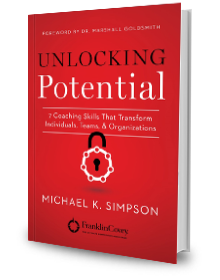 This book provides a great overview of coaching. The author has a clear mentality of abundance, feeling that the primary job of a leader is to help his people grow. We are all born with the potential to succeed and the leader helps to unlock that potential in others.
This book provides a great overview of coaching. The author has a clear mentality of abundance, feeling that the primary job of a leader is to help his people grow. We are all born with the potential to succeed and the leader helps to unlock that potential in others.
The book reviews 7 key coaching skills that make for an effective leader/coach. I think each of the 7 skills could be lengthy books by themselves but as an overview of coaching Simpson does a good job addressing them to an appropriate degree.
The 7 skills are:
* Build Trust
* Challenge Paradigms
* Seek Strategic Clarity
* Execute Flawlessly
* Give Effective Feedback
* Tap Into Talent
* Move the Middle
One of the key insights I gleaned was from the section that discusses question based coaching. The author teaches that the most effective way to coach is to ask questions. This ensures that the insights come from within the individual and truly unlock existing potential.
I also loved the idea of moving the middle. Directly identify those members of the middle of the organization that can easily adopt the patterns of top performers and become tomorrow’s leaders.
I recommend this book to anyone who may find themselves in a leadership position at school, home, work, church, or in any other meaningful life arena.
Original article: Unlocking Potential by Michael Simpson.





November 5, 2014
The Road to Reinvention by Josh Linkner
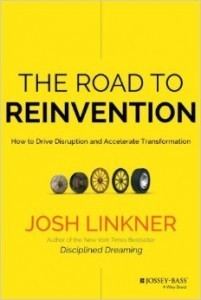 I recently finished reading “The Road to Reinvention” by Venture Capitalist and best selling author Josh Linkner. The cover of the book illustrates the innovation of the wheel in history. This jumped right out to me right when I picked up the book since we have grown accustomed to telling people “don’t reinvent the wheel.” I suppose we should all be glad that the wheel has been reinvented so many times and it probably will be reinvented again.
I recently finished reading “The Road to Reinvention” by Venture Capitalist and best selling author Josh Linkner. The cover of the book illustrates the innovation of the wheel in history. This jumped right out to me right when I picked up the book since we have grown accustomed to telling people “don’t reinvent the wheel.” I suppose we should all be glad that the wheel has been reinvented so many times and it probably will be reinvented again.
Josh poses the argument that if we don’t put ourselves out of business somebody else will. At the core of a successful organization, department, or individual is the drive to constantly innovate, change, and reinvent. He divides the book up into 8 core sections which are:
1. Let go of the past.
2. Encourage courage.
3. Embrace failure.
4. Do the opposite.
5. Imagine the possibilities.
6. Put yourself out of business.
7. Reject limits.
8. Aim beyond.
One of my favorite insights was the need to reinvent processes. Sometimes we get stuck assuming that innovation and reinvention need to happen in our product line and development. Sometimes the biggest breakthroughs happen when we take a bigger look at the way we do something and reinvent the process. Organizations need to stop doing things the way they have always been done.
I also appreciated a very short section of the book that talks to the need of creating a company culture to support reinvention. Specifically I thought this book put a rather complex topic like company culture, very simply, but suggesting that cultures are made up of rituals. While we often feel like culture is an intangible, rituals are something that we can both influence and often invent and control.
I would recommend this book to anyone who all entrepreneurs and business executives and any individual who feels like they need a change.
Original article: The Road to Reinvention by Josh Linkner.






October 22, 2014
Should You Buy Email Lists For Marketing?
No, you shouldn’t. If all you needed was an easy answer, then there you have it. If you want to understand the deeper reasons why and explore alternatives to building an email list of your own read on.
Email marketing was recently ranked the number one highest return on investment marketing strategy by US marketers in a study published by emarketer.com. Email marketing leads to big ROIs because its relatively cheap to execute and is very easy to measure. Sadly, it is also difficult to get started as most of us start with few if any contacts in our email marketing subscriber lists. The temptation to buy an email list is very high. This is especially true in the B2B space where many marketers feel like it would be impossible to construct a list on their own.
Why Its Generally A Bad Idea?
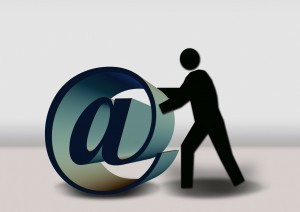 At the core of Email Marketing is deliverability. Deliverability is the term we use to describe and understand the factors that get your sent emails into the inbox of the recipient as opposed to getting caught in a server level firewall or email client junk folder. There are a myriad of factors that contribute to getting to the inbox. Chief among these is your Sender IP reputation. Your IP reputation is the reputation that the ESPs (Email Service Providers) build over time about the quality of the email you send. When you buy an email list you potentially damage your reputation in a few ways. First the ESPs consider it a red flag when they see a spike in the quantity of email being sent out from any given source. Going from sending email campaigns from 500 to 5,000 over night is a red flag that will damage your sender reputation. Also, most email lists inherently contain bad email addresses that will damage your reputation. Due to the way most lists are built they are prone to have a lot of inactive email accounts. When you send email to an inactive email account the ESPs lowers your sender reputation and this is especially damaging when you do it in bulk which is what often happens when you buy an email list. Additionally, ESPs also create fake/dead email accounts that they then submit to a lot of the list builders. They do this on purpose so that when anyone sends email to that fake account the ESP will know that the sender is SPAMing and not gathering email addresses organically.
At the core of Email Marketing is deliverability. Deliverability is the term we use to describe and understand the factors that get your sent emails into the inbox of the recipient as opposed to getting caught in a server level firewall or email client junk folder. There are a myriad of factors that contribute to getting to the inbox. Chief among these is your Sender IP reputation. Your IP reputation is the reputation that the ESPs (Email Service Providers) build over time about the quality of the email you send. When you buy an email list you potentially damage your reputation in a few ways. First the ESPs consider it a red flag when they see a spike in the quantity of email being sent out from any given source. Going from sending email campaigns from 500 to 5,000 over night is a red flag that will damage your sender reputation. Also, most email lists inherently contain bad email addresses that will damage your reputation. Due to the way most lists are built they are prone to have a lot of inactive email accounts. When you send email to an inactive email account the ESPs lowers your sender reputation and this is especially damaging when you do it in bulk which is what often happens when you buy an email list. Additionally, ESPs also create fake/dead email accounts that they then submit to a lot of the list builders. They do this on purpose so that when anyone sends email to that fake account the ESP will know that the sender is SPAMing and not gathering email addresses organically.
What Are Your Alternatives?
Building an email list is difficult. Ensure that you are producing and sending out super valuable content for your target audience and beyond the valuable content consider giving additional incentives to people to opt-in. Free reports, coupons, opportunities to win something, or the like. Proactively add email addresses from online contacts but use double opt-in to allow every contact the opportunity to confirm their subscription or pass on it. Here is a blog post I prepared a few years ago that has some other specific ideas.
If You Ignore My Advice and Buy a List How Can You Mitigate The Risk?
First, slowing warm up your IP sending by only adding small portions of the list to your active subscribers over time. This gradual warm up in sending quantity will both limit the potential red flag as well as give you some immediate feedback on the quality of the list based on your bounce rate (% of inactive or bad email addresses).
Second, consider sending out “confirm your subscription” email that lets the user know that you would like to send them a lot of awesome future content and ask them to click on a link in the email to confirm their subscription. You can send out 1 or maybe 2 follow up emails reminding them to click to confirm but after a few of these invitations delete them from the list or leave them marked as inactive.
Original article: Should You Buy Email Lists For Marketing?.






October 15, 2014
Do Digital Marketers Need to Know All Of This?
Marketing and Advertising present a very complex environment. Marketing experts have to surround themselves with people who have expertise in each part of the marketing cycle and the various mediums where marketing and advertising are placed. Within the digital space there are a lot of unique media and marketing systems used by today’s experts. Below is a quick summary of some of the higher level parts of the digital marketing ecosystem for those who may be beginners and are trying to understand the moving parts.
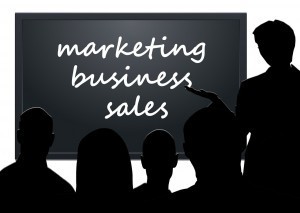 For the digital marketers out there I have to wonder; do we have to know all this stuff really well? Digital marketing expertise is hard to find in our current marketplace. For smaller companies who may not have the budget to bring on a full team of marketers to represent these different facets its going to be difficult to find someone who has a moderate to deep understanding of all of them. As far as making yourself a strong asset in the job market is it better to be widely versed or deeply versed in one or two different media?
For the digital marketers out there I have to wonder; do we have to know all this stuff really well? Digital marketing expertise is hard to find in our current marketplace. For smaller companies who may not have the budget to bring on a full team of marketers to represent these different facets its going to be difficult to find someone who has a moderate to deep understanding of all of them. As far as making yourself a strong asset in the job market is it better to be widely versed or deeply versed in one or two different media?
I would say both. For the large and small players in the game there is a need for leaders and marketing managers who can talk all the talk and form high level strategies based on a working knowledge of all the aspects of the ecosystem. And that isn’t limited to digital. Getting experience and training around traditional ad platforms like TV, radio, outdoor, and print is also key. Within the best organizations however there is also a need for people who are more deeply versed in one specific vertical or medium. Depending on where you currently are in your career in the digital marketing or more broad marketing spectrum in learning and building a track record, you may choose to go niche or broad. Pick your poison and drink it often!
Email isn’t dead. Ranked number one in a recent study among US marketing professionals as the highest ROI medium of digital advertising, email marketing is a critical component of any company’s strategy no matter the size.
Social
Understanding how to create utility and engagement in the social space is as much an art form as any other marketing medium. Often considered a low cost to free solution, social marketing is a place to invest resources and expertise in order to build short and long term results.
Mobile
Speaking here more specifically to SMS and MMS marketing, retailers and big brands can leverage the number one most responsive communication tool to connect with consumers and drive them to action.
SEO
Currently 70% of online ad budgets are allocated to SEO. This moving target marketing method is about optimizing one’s site to make it rank better on the organic algorithms of major search engines like Google. Its half cat and mouse games with the search engines and half an issue of creating truly valuable content and utility in a way that is compatible with technology best practices.
SEM
I prefer to use the term Paid Search but SEM is the term most often used to refer to the practice of buying paid ads (generally pay per click) on search engines like Google based on the location and keywords used by the searcher. The ultimate compliment to SEO efforts.
Display & Rich Media
Generally referring here to banner ads, streaming audio, and video pre-roll sold direct to site, through an ad network, or through an ad exchange while using a high number of data and profile targeting filters and parameters to make sure the ad is being shown to the right people at the right place at the right time at the optimal price.
Data and Analytics
The key need to look at the large amount of data coming from owned, earned, and paid media and advertising across all these various media and come up with key insights that strengthen future marketing efforts and products.
Original article: Do Digital Marketers Need to Know All Of This?.






October 8, 2014
The “It’s Not About Me Moment”
I was on a hike with some friends recently. Adam, a friend started to tell me about a time many years ago when he attended a talk by Stephen R. Covey in which he spoke of the importance of focusing on others. My friend Adam told me that was the beginning for him. The beginning of a new paradigm of work, family, career, and so much more.
 I can relate. I had a similar moment in 2006 when I attended a retreat where a very smart man named Les spent a few hours explaining the difference between producers and consumers. That was the day when I understood that life is about creating value for others.
I can relate. I had a similar moment in 2006 when I attended a retreat where a very smart man named Les spent a few hours explaining the difference between producers and consumers. That was the day when I understood that life is about creating value for others.
Every successful person has a moment like that. A moment when they realize life is about creating value for others. There are a lot of people in the camp of naysayers who think it’s truly a load of crap. These are the people who think work is about making money and money is about being happy. They are of course wrong and their passion for cash will only get them so far.
What was the moment for you?
Original article: The “It’s Not About Me Moment”.






October 6, 2014
The Glare of the TV On The Window – A Confused Society
I run at night. My wife works out in the mornings before I go to work so I can watch the kids and I work out at night after the kids go to bed. In these late night runs through our neighborhood I see one thing more consistently than anything else. People watching TV. Isn’t it amazing how our obsession with TV stops us from achieving our dreams? Some people even feel that they have to watch TV in order to unwind and prepare for sleep.
 The average American watches more than 10 hours per week of television. I don’t need a calculator to figure out that is at least 520 hours of TV each year, which equates to about 22 days. Over the course of a year its amazing to consider that the average American watches enough TV to cover 22 full days. If you take out 8 hours a day for sleep then it would take 32.5 days to watch 520 hours of TV. Over a month each year!
The average American watches more than 10 hours per week of television. I don’t need a calculator to figure out that is at least 520 hours of TV each year, which equates to about 22 days. Over the course of a year its amazing to consider that the average American watches enough TV to cover 22 full days. If you take out 8 hours a day for sleep then it would take 32.5 days to watch 520 hours of TV. Over a month each year!
Some television programming and movies are inspiring and educational. It can also be a good way for people to spend a little time together. Upon reflection however, couldn’t you easily think of an activity that provides better education, inspiration, or a more effective way to spend time with the people you love?
In the next 12 months what could you achieve if I handed you an extra 32 days? What if you cut your “average” TV consumption from 10 hours per week to only 5 hours per week? What could you do with those 16 extra days in the next 12 months? Could you finish the basement? Could you start that business you’ve been thinking of? Could you climb a mountain, go on a vacation, build something with your children?
Time is not only a precious and limited resource its also an expendable one. We can never get it back after it goes by. The best stewards use their time as a tool to produce more value for more people. What will you do with your extra 32 days next year?
Original article: The Glare of the TV On The Window – A Confused Society.









